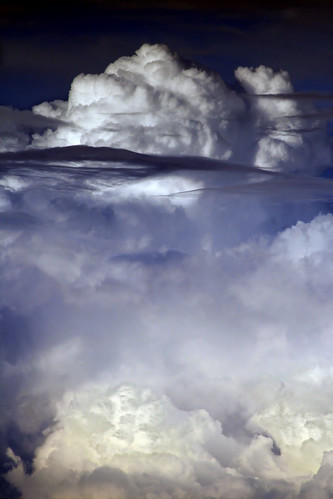
"What are you looking for?" I asked him.
"The rabbit," he said. I rolled my eyes -- unconcerned he might see, because his own were pointed skyward. He always did this. Ask him where his shoes are, or to wipe up the milk, and the mouth goes slack and the eyes roll upward. What the hell is up there?
"Maybe it's behind the bush," I suggested reasonably. A jackrabbit, legs at awkward angles and ears radiating away the afternoon heat, had just loped behind a massive creosote.
"No, Mom," he said. "Up there." (Here "Mom" sounded like "Dumbass" and "Up there" sounded like "Are you high?")
"The rabbit chasing the crocodile," he added as if this clarified the matter. I followed his gaze -- and sure enough, there was a rabbit. To be fair, it had mutated; the ears looked more like antennae and the tail had either elongated or (my son's favored explanation) disappeared behind a particularly long bowel movement. It was indeed chasing a crocodile. The latter appeared to be responding to this encroaching threat by detaching its own tail.
I was late to the game, but we had resumed cloud watching.
It's become a routine. Children, I read recently, become disconsolate each day as the afternoon approaches and passes. The light
 changes; they re-realize that passage of time occurs and that this day will soon end. They despair.
changes; they re-realize that passage of time occurs and that this day will soon end. They despair.I don't know about that, but I do know that my son is a freaking jerk if I let him sit on the couch throughout the afternoon. On such days, our conversations go something like this:
Me: Sweetie, why don't you get some homework done? Or demonstrate in some way that you're still among the living?
Him: Mooom! Stop it!
Me: Excuse me?
Him: Stop bossing me a-round!
Me: I don't know why you think you can get away with that attitude, but you can either cut it out or go in the corner and then do your homework anyway.
Him: Mumble mumble whine whine Moooom whine cry mumble sniffle.
Me: Just do your work, and I'll forget it.
Him: No, THANK you! (Flounces to corner, where he sends me Screw you, Mom vibes with his eyeballs.)
He apologizes within sixty seconds and is extra lovey for the  rest of the day, but I'd just as soon forgo the experience. We'd sought the solace of the neighborhood park. We were outside for the sheer joy of it, but also to head off any onslaught of grouchiness. It was working.
rest of the day, but I'd just as soon forgo the experience. We'd sought the solace of the neighborhood park. We were outside for the sheer joy of it, but also to head off any onslaught of grouchiness. It was working.
 rest of the day, but I'd just as soon forgo the experience. We'd sought the solace of the neighborhood park. We were outside for the sheer joy of it, but also to head off any onslaught of grouchiness. It was working.
rest of the day, but I'd just as soon forgo the experience. We'd sought the solace of the neighborhood park. We were outside for the sheer joy of it, but also to head off any onslaught of grouchiness. It was working.He stood in the shade created by my body -- nothing like being used as an awning to make one feel nice and petite -- and pointed out a  particularly shapely cumulus mediocris (as wide as it is tall) that looked like a fat skull when viewed one way, or flowers another. He preferred the skull. Then he just stood and stared, his index finger half-pointing but forgotten. The gaze and slackened jaw looked more awed than stupid now. An easygoing breeze chased itself in gentle gusts around the trees as birds skimmed the branch tips, and he stared at clouds as solid-looking as mountains, as tall too, but mutable and morphing like the globs in a lava lamp. A knobby, marbly bit of cloud poked from the rest of the mass and was edged with brilliant while light, reminding me of a kid I'd seen once peeking out of the curtains before a school talent show. David absent-mindedly made a "poof" motion with his hand, like you would do to flick water. His fingers stayed open.
particularly shapely cumulus mediocris (as wide as it is tall) that looked like a fat skull when viewed one way, or flowers another. He preferred the skull. Then he just stood and stared, his index finger half-pointing but forgotten. The gaze and slackened jaw looked more awed than stupid now. An easygoing breeze chased itself in gentle gusts around the trees as birds skimmed the branch tips, and he stared at clouds as solid-looking as mountains, as tall too, but mutable and morphing like the globs in a lava lamp. A knobby, marbly bit of cloud poked from the rest of the mass and was edged with brilliant while light, reminding me of a kid I'd seen once peeking out of the curtains before a school talent show. David absent-mindedly made a "poof" motion with his hand, like you would do to flick water. His fingers stayed open.
Luke Howard, a Quaker and chemist I've been hearing about from David lately, who made up names for the clouds in a specific year I'll totally look up later, was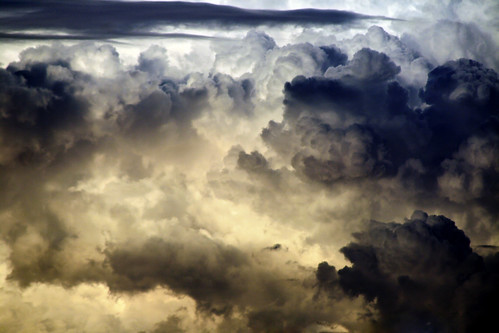 obsessed with clouds. He began at age ten to keep a weather journal. By fifteen, he recorded the weather conditions twice a day, using a thermometer, weather vane, rain gauge, and barometer. I'm not even sure I remember exactly what a barometer does.
obsessed with clouds. He began at age ten to keep a weather journal. By fifteen, he recorded the weather conditions twice a day, using a thermometer, weather vane, rain gauge, and barometer. I'm not even sure I remember exactly what a barometer does.
 particularly shapely cumulus mediocris (as wide as it is tall) that looked like a fat skull when viewed one way, or flowers another. He preferred the skull. Then he just stood and stared, his index finger half-pointing but forgotten. The gaze and slackened jaw looked more awed than stupid now. An easygoing breeze chased itself in gentle gusts around the trees as birds skimmed the branch tips, and he stared at clouds as solid-looking as mountains, as tall too, but mutable and morphing like the globs in a lava lamp. A knobby, marbly bit of cloud poked from the rest of the mass and was edged with brilliant while light, reminding me of a kid I'd seen once peeking out of the curtains before a school talent show. David absent-mindedly made a "poof" motion with his hand, like you would do to flick water. His fingers stayed open.
particularly shapely cumulus mediocris (as wide as it is tall) that looked like a fat skull when viewed one way, or flowers another. He preferred the skull. Then he just stood and stared, his index finger half-pointing but forgotten. The gaze and slackened jaw looked more awed than stupid now. An easygoing breeze chased itself in gentle gusts around the trees as birds skimmed the branch tips, and he stared at clouds as solid-looking as mountains, as tall too, but mutable and morphing like the globs in a lava lamp. A knobby, marbly bit of cloud poked from the rest of the mass and was edged with brilliant while light, reminding me of a kid I'd seen once peeking out of the curtains before a school talent show. David absent-mindedly made a "poof" motion with his hand, like you would do to flick water. His fingers stayed open.Luke Howard, a Quaker and chemist I've been hearing about from David lately, who made up names for the clouds in a specific year I'll totally look up later, was
 obsessed with clouds. He began at age ten to keep a weather journal. By fifteen, he recorded the weather conditions twice a day, using a thermometer, weather vane, rain gauge, and barometer. I'm not even sure I remember exactly what a barometer does.
obsessed with clouds. He began at age ten to keep a weather journal. By fifteen, he recorded the weather conditions twice a day, using a thermometer, weather vane, rain gauge, and barometer. I'm not even sure I remember exactly what a barometer does.David pointed out a stretch of clouds above the cauliflower mass we'd been studying. It looked like a few streaks of cream cheese frosting spread too thin (everyone knows frosting you can see through is way too thin) over the sharp blue sky.
"Cool," I said. "Stratus clouds too!"
"Actually, Mom, I think they're cirrus clouds. Stratus are the lower-down ones," he answered distractedly, extending a thumbs-up before his face as if to frame a picture, but instead pretending to smear it along the wispy clouds.
I looked it up later. He was right
 , of course.
, of course.David probably knows what a barometer does. He wants to be like the "cloud namer guy," he said. I bet Luke Howard looked in the air for his shoes too.
The science club where Howard introduced his paper in the early 1800s -- entrenching stratus, cirrus, and cumulus in meteorology talk and cotton-ball-bedecked construction paper forever after -- had recently featured a "demonstration" of laughing gas, in which, apparently, they watched each other stumble around the stage for the hell of it. Classy sophisticates they were not. But I bet they knew the day would be cloudy if a pine cone's scales were down. They knew what a barometer did. They knew their cirrus from stratus, even before they had names. I bet they finger painted the cirrus clouds.
Howard's achievement was to use a system
 to give clouds their own names and character, rather than writing them off as gods in the sky and calling it a day. He chose Latin words, modeling his system after Linnaeus. (Fortunately -- or perhaps unfortunately if you're my husband or son -- he chose carefully, and we aren't obliged to point out well formed, billowy labia or a particularly shapely phallus formation.)
to give clouds their own names and character, rather than writing them off as gods in the sky and calling it a day. He chose Latin words, modeling his system after Linnaeus. (Fortunately -- or perhaps unfortunately if you're my husband or son -- he chose carefully, and we aren't obliged to point out well formed, billowy labia or a particularly shapely phallus formation.)David came home with all this information recently, and has wanted to cloud gaze since then. He's done the requisite blue-paper-with-cotton-balls-glued-to-it activity (Of course I can tell one cloud from another, I lied), and his bonus spelling word the other day was cumulonimbus. He's just scratched the surface, but while I turn at once to a book, he remembers to just look at stuff if he wants to learn about it.
So I followed his example.
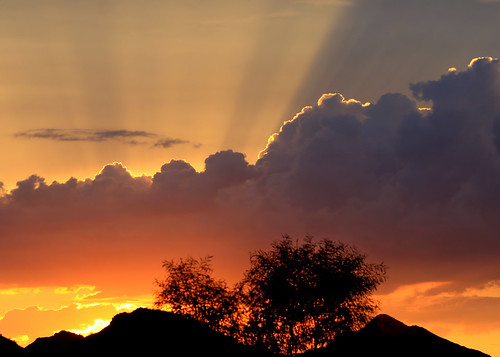 A week later, I can't believe I ever had a hard time telling stratus from cirrus. I can't believe I went first to a book for the answer, instead of the sky.
A week later, I can't believe I ever had a hard time telling stratus from cirrus. I can't believe I went first to a book for the answer, instead of the sky.Another thing: Arizona, especially right now, is awesome for clouds. Somehow, I never knew that.
Cumulus are my favorite. Clouds that look solid, not even soft really, fascinate me. The raw cauliflower texture; the bits of harsh white light and spots of navy blue shadow, so that it leaves an after image when I take a picture and look away to blink; the climbing and work I need to do to view them properly over the city's detritus as they droop on the horizon; all draw me as no other formation seems to. The dense, chunky, sharply defined forest of white domes heaps together in some irresistible manner ("cumulus" is Latin for
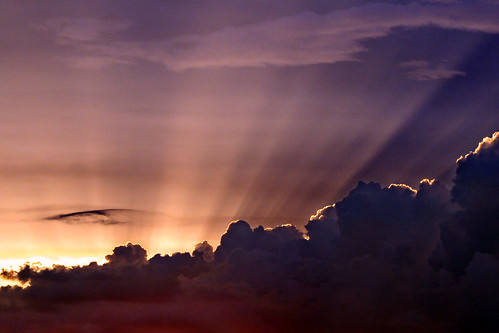 "heaped"). This is the reason I never really got Wordsworth's "I Wandered Lonely as a Cloud," which is otherwise a lovely meditation. I got stuck at "cloud" and pictured one of these. Never mind the daffodils -- what, I wondered, could be lonely about a robust, lively, conglomerated force like this? I'd love to be a droplet in a cumulus. I'd never, ever be lonely. Cumulus are the "cloud-shaped" clouds, and their basic cloud outline was pretty much the staple (and limit) of my artistic endeavors in school.
"heaped"). This is the reason I never really got Wordsworth's "I Wandered Lonely as a Cloud," which is otherwise a lovely meditation. I got stuck at "cloud" and pictured one of these. Never mind the daffodils -- what, I wondered, could be lonely about a robust, lively, conglomerated force like this? I'd love to be a droplet in a cumulus. I'd never, ever be lonely. Cumulus are the "cloud-shaped" clouds, and their basic cloud outline was pretty much the staple (and limit) of my artistic endeavors in school.But David's right; cirrus are pretty awesome too. They're the high-flung, streaky, smeary tendrils and wisps. Cirrus is Latin for "lock of hair," but they seem even more ephemeral than that, though I know they're made of billions to trillions of ice crystals. They seem to spread, drift, separate and rejoin more readily than other cloud types, but don't quote me on that. They feahter and swirl, unreeling and curling tails back on themselves. The ones David and I saw that day looked like wild flowing tresses, fraying and tangling, unfurling and overlapping one another before morphing once again or dissolving entirely.

Stratus clouds are another beast. They're the ones I notice least. During most of the day, even if they're there, you probably won't notice them either. They're soft, diffuse, featureless sheets. However, if you've ever been in a cloud (fog, that is) it was a stratus. And they really come into their own at sunrise or sunset. Their boringness almost makes it more rewarding, since I'm dumb enough to be surprised nearly every time. I'll check the sky and see a palette of totally blah clouds, and prepare to call it a day. Then, just as the sun hits the houses across the street, the stratus clouds act like a sky-sized softbox, bouncing a brilliant diffuse glow of pink or gold or pumpkin orange through our dining room window. If we go outside -- as we nearly always do -- we're rarely disappointed. The flat clouds stay dark throughout about half of their masses, but the bottom half will be a resplendent, textured gradation from purples and maroons all the way through red and orange, to the bottom, where the light escapes in a lemony yellow burst. Nothing catches light quite like a stratus.
And then there are the cloud moments scattered throughout the last week or so, since I began to notice.
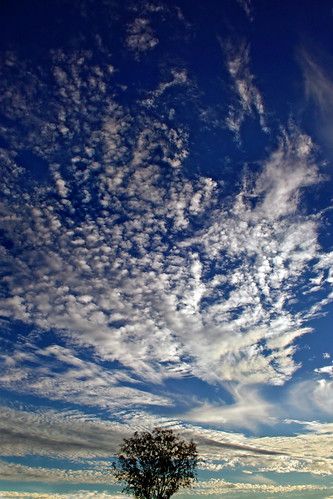
I was driving to the library the other day and saw a turkey vulture flying in the opposite direction, below a massive scaffolding of altocumulus (The big fleecy conglomerations of cloudlets; in this case it looked like perfectly spaced crop rows). The formation, combined with our opposing directions, made the vulture appear to be shooting through the sky even as it lazily tipped and soared.
A collection of overstuffed cumulus merged, turned dark brown-gray and developed into a towering cumulonimbus as David and I watched from the swing set in the backyard. We watched the mass (a cumulonimbus can be up to 60,000 feet high, more than twice as tall as the world's highest mountain) as it flickered. Lightning flashed from somewhere deep inside it and thunder rumbled through its thick billows. My hair stung my eyes as a gust whipped it, doves made tiny black arrows against the sky as they flew for cover, and a lizard sat on the slide, doing push-ups and looking apprehensive. All at once the cloud released its potential, big fat drops raising their own mini-clouds in the dust of the parched ground. Within fifteen minutes the rain cleared (I heard later three inches had dropped in those fifteen minutes in some areas). Everything was drowned in a yellow light. I saw a spaghetti-thin tail disappear as the lizard ran for cover.
At sunset, David leaned precariously from a ladder, craning to capture the entire thing in his viewfinder as he snapped picture after picture. (I don't know where he picked up that habit.) A long thin cloud, pale and shiny like a scar at first, was suddenly lit from behind. Fine lines of deepest red and blazing yellow singed the horizon as, at last, colors bled together and finally drained from the day. David asked me to write that there were stratus and cumulus. I grab a notepad from the patio that on which I'd written a note to myself earlier that week: We are all symbiotic. (What had I meant by that?) I turned it over, took his notes. He found a feather we think is from a hawk and held it up to the light. The sun highlighted and defined each barb. He held it at arm's length and pretended to brush the clouds into the sky. Just before dipping out of sight, the sun cast rays from the lowermost cloud -- crepuscular rays, which the Maori say are ropes restraining the sun to make the day last longer. The otherwise dull stratus clouds held the sun until the last second, casting warm, soft echoes to us. Like breathable light.
I put my notes away, David grabbed the hawk feather, and we headed in. I prayed for rain the next day, but especially for clouds.

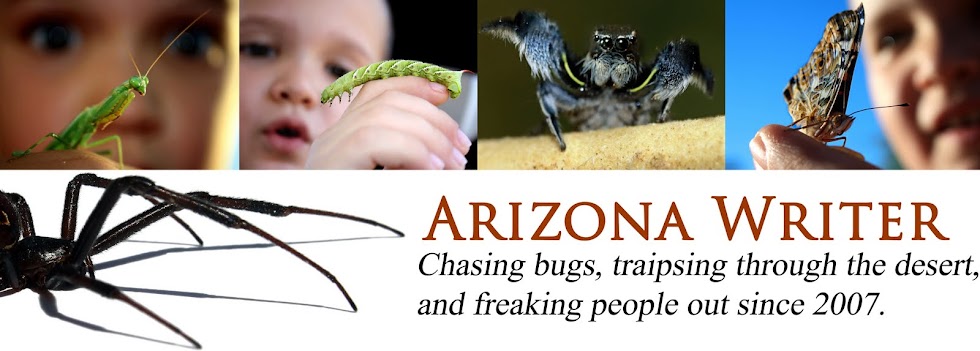
9 comments:
Gorgeous cloud photos!
Great information and better shots. Awesome is the right word.
Great information and better shots. Awesome is the right word.
I don't think I've looked at clouds with this much passion since I was about 12 years old, and this post had me DYING to get outside and stare at the sky. And I agree with previous comments, awesome pictures.
Your blog reminds me of my childhood. I've had fun with my grandchildren enjoying the clouds of imagination. Beautiful pictures!
Sweet blog, I hadn't noticed arizonawriter.blogspot.com earlier in my searches!
Carry on the great work!
Thank you, I have recently been searching for information about this topic for ages and yours is the best I have discovered so far.
Hey - I am really delighted to find this. great job!
Post a Comment